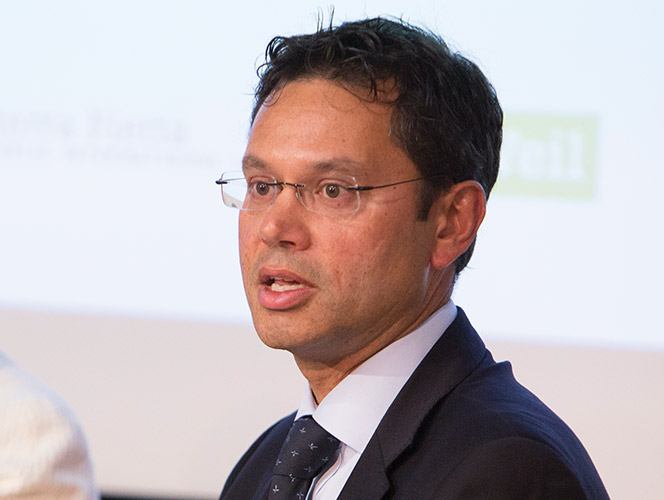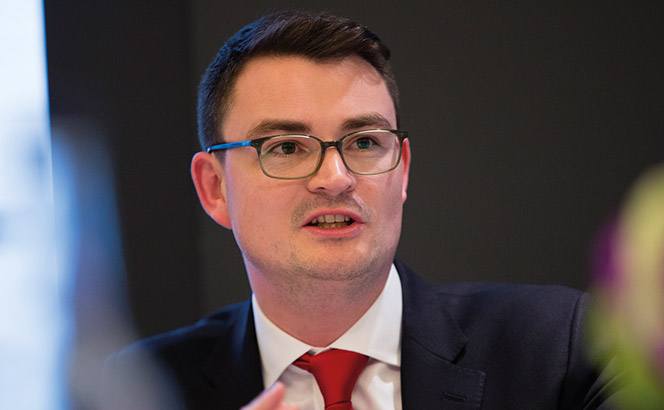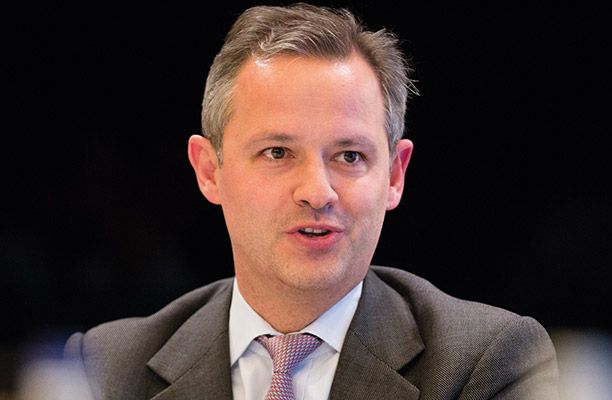Continue reading “Journey into the unknown – upgrading operations and tech”
The innovation illusion
Hired help – bringing new skills to legal teams
All restless souls – City firms braced as partnership goes Millennial
Bigger, longer, more complicated
‘Arbitration has gone from being the exotic bird of dispute resolution to become almost the norm,’ argues Constantine Partasides of Three Crowns (3C).
The appearance of boutiques such as 3C and Hanotiau & van den Berg is itself a sign of arbitration’s entry into the mainstream. It is tempting to consider parallels with the US-based litigation firms that emerged in the late 1980s and ’90s, when Quinn Emanuel Urquhart & Sullivan and Boies Schiller Flexner broke away from the full-service model to focus on disputes work.
Whether the market will offer enough work for arbitration-only firms to grow into several-hundred-partner international outfits remains to be seen, though no-one expects to see a slowdown in client demand. And the cases themselves are becoming more complex. ‘The smallest case I am currently handling is $250m,’ notes David Goldberg of White & Case. ‘The next smallest is worth over $14bn. At the top end of the market, arbitrations have become much more hostile, larger value, higher stakes and are taking far longer to resolve.’
Arbitration lawyers are seeing major changes in the infrastructure surrounding their practice, with new arbitral institutions, third-party funders and expert witnesses all changing market dynamics.
We teamed up with Navigant Consulting to poll a global sample of arbitrators, and find out how surging demand and new developments are shaping the way arbitration teams operate, building on the views of 239 senior arbitration lawyers representing over 80 different firms globally. We also got the views of some of the world’s leading arbitrators on what they think these changes mean for international arbitration.
A rising tide
Recovering financial loss was by far the main motive clients had for engaging in arbitration proceedings – over two thirds (66%) of partners said this was the driving factor in their caseloads.
‘Banks are starting to doubt that the courts are best placed to provide certainty and predictability in a fair number of jurisdictions.’
– Gary Born, WilmerHale
While construction and energy remain the dominant sources of work, arbitration is spreading beyond its traditional markets. Just under a third (28%) of those surveyed specialised in financial services arbitration, while nearly a fifth (18%) specialised in life sciences disputes.
‘Around ten years ago most arbitrators would have told you that banks don’t like to arbitrate because they prefer the certainty and predictability provided by the courts and that IP disputes are not even arbitrable,’ comments Gary Born, the heavyweight chair of the 70-strong international arbitration group at Wilmer Cutler Pickering Hale and Dorr (WilmerHale). ‘Clearly, neither of those things is true. Banks are starting to doubt that the courts are best placed to provide certainty and predictability in a fair number of jurisdictions and a growing number of patent licence cases or other types of IP disputes are going to arbitration.’
While financial services arbitration is growing, Philip Clifford QC of Latham & Watkins warns that pathological contracting is still endemic when it comes to disputes. ‘Financial institutions try to hedge their bets by having options clauses allowing them to opt for either litigation or arbitration as it suits them at the time. The problem is that although it’s fine under English law, it’s not fine in other jurisdictions and that can invalidate the arbitration clause. Yet they do it time and again.’
Expert witnesses: impartial observers or hired guns?
The growing number of expert witnesses in arbitrations has been a notable feature of trials for the last decade. It has become almost the rule to have a quantum expert involved in any large-value case, while tribunals tend to get lost in esoteric areas, like gas pricing, fairly quickly and will typically rely on experts for guidance.
While the expert witness is now a well-established feature of many arbitrations, the rising number of witnesses has led to a shift in their role. Matthew Secomb of White & Case comments: ‘It is becoming much more common to see people sell their services to this market and with that comes a new level of professionalism among expert witnesses.’
In theory the expert’s role is to give an opinion, but in practice they package a lot of material in a way that is easily digestible by the arbitrators. The user-friendly, polished reports may be far superior to the materials produced by part-time consultants, but many feel it has come at a cost. As Secomb adds: ‘When it comes to the validity of an opinion, they are often a bit removed from the technical skill on which they are opining.’
Gary Born of Wilmer Cutler Pickering Hale and Dorr has a similar take. ‘Experts used to be hands-on specialists in a particular field, who did disputes consultancy work on the side. Now there is a whole industry of people whose primary means of supporting themselves comes through selling witness services to the disputes industry. It doesn’t mean we are seeing more expert witnesses in arbitrations, but there is a greater choice of experts out there.’
As a result, says Three Crowns’ Constantine Partasides, there is more nervousness in tribunals about the role expert witness are playing. ‘The big expert-witness hubs are coming to be seen as another form of advocate sent in to argue a case, which means their evidence is of lesser value.’ Simmons & Simmons’ Stuart Dutson adds: ‘Increasingly, tribunals are faced with two diametrically-opposing expert reports and there is little or no movement in their views.’
Herbert Smith Freehills’ Justin D’Agostino says tribunals are responding to this proliferation of experts by becoming more proactive in determining how such advisers can enter the process. ‘We are definitely seeing more tribunals ask parties to identify at the outset the disciplines they want to consult experts on and the specific questions they want these experts to address. This shows a more sophisticated approach to evidence by the tribunals, but it needs to go further. The next stage in the evolution of evidence in the arbitral process is to have tribunal-appointed experts determining the answer to these questions.’
Arbitrations involving financial services and intellectual property (IP) disputes may be growing, but it is notable that specialist institutions for resolving these disputes have failed to gain traction with the wider community of arbitrators.
For example, P.R.I.M.E. Finance (Panel of Recognised International Market Experts in Finance), has yet to take off, in spite of the strong reputation of its founders, Jeffrey Golden and Lord Woolf. The Arbitral Centre of the World Intellectual Property Organization (WIPO), established in Geneva in 1994 as a specialist forum for IP disputes, has met a similar lack of interest.
The reason, Michael Polkinghorne of White & Case suggests, is that such institutions have been caught in a catch-22. ‘Users want an institution that has done the process a large number of times and, while an institution can be specialised by design, it can’t be experienced by design. It’s the familiar problem states like Qatar have faced in trying to launch their own regional centres. It is very difficult to get people to bring an arbitration to your state without a track record and it is very difficult to build a track record if people won’t bring cases to your state.’
Adds Born: ‘It is not clear why something like WIPO would be better at appointing specialised arbitrators than any other institution. Many of the major forums now have their own panels that specifically handle IP disputes. They also have a much larger caseload and hence both a wider experience with arbitrators and greater experience of applying procedural rules, which is likely to lead to consistent and reliable rulings. Specialising in one field can be counterproductive. Often it is not a question of whether you know of a good IP arbitrator, but whether you know one who speaks Farsi or has got experience with technology deals in Taiwan.’
The results of our survey give wide support to the notion that arbitrations are becoming more complicated. Of the 239 partners surveyed, 72% said the typical cases they were involved in were larger or more complicated compared to three years ago.
‘There are more patents registered in Shenzhen than in the rest of the world. If London wants to maintain its position it will have to appeal to these new markets.’
– Stuart Dutson, Simmons & Simmons
As a result of this growing complexity, partners are finding themselves spending longer preparing evidence (65%) and consulting with clients on the best approach (63%). However, clients are increasingly expecting their firms to give an advanced estimate of the cost of a matter.
Matthew Secomb of White & Case comments: ‘The demand for pre-estimation of costs is one of the most notable shifts in the market over recent months. The problem is, a lot of lawyers are desperate for the work so have a natural tendency to low-ball the estimate. It is an unstable business model and we are seeing cases being handled for a fee that must be break-even at best, and most likely represents a loss to the firm involved.’
Surprisingly, just over a fifth (21%) of arbitration lawyers are responding to client pressure by recommending the use of forums that restrict or limit the duration of the hearing (see ‘The rise of Asian centres’). However, as Stuart Dutson of Simmons & Simmons notes, while forums and arbitrators are often blamed for prolonged and costly hearings, many of the problems clients encounter could be solved by involving arbitration lawyers earlier in the process. ‘Too often parties overlook the initial drafting and end up with a process that allows parties to delay things by making endless applications. The response is usually to blame the forum or the arbitrators, but there’s not much anyone can do if they agreed to those rules at the outset.’
More in word than in deed – third-party funding
The one thing everyone knows about arbitration is that it can be an expensive business. Increasingly, even companies with the resources to arbitrate are looking to share the financial risks by turning to third-party funders. While funding has been popular in investor-state arbitration for years, its use in commercial cases is more recent. Not only has the number of cases involving funders reportedly grown, but the range of situations parties are seeking funding for has diversified to include everything from securing immediate payment to covering the insurance risks of an award not being enforced.
The new New York Convention
The infrastructure supporting arbitration, including the New York Convention, was designed for a world where arbitration was not so widely used. It may now be creaking under the weight of cases, says David Goldberg of White & Case. ‘The legal services market in international arbitration has multiplied a thousand times in a short period of time. Previously there were a lot of unwritten rules followed by practitioners that everyone tacitly agreed to and which governed the industry. That is now impossible. With so many law firms from so many jurisdictions doing arbitration there can be problems of, broadly, an ethical nature.’
‘The fundamental issue of the New York Convention on enforcement of foreign arbitral awards needs to be addressed. It is by far the most successful international legal convention in human history, but it is grossly outdated. I don’t see how we can continue our practice based on a 60-year-old document.’
While third-party funding is much discussed as a concept, its use does not appear to be as widespread, says Latham & Watkins’ Clifford. ‘Much like treaty arbitration, the subject generates a lot of noise, but the overall number of cases with that as a feature is fairly small. I have my doubts that anything like the number of cases are being funded as funders would have you believe.’ Another senior arbitration lawyer comments: ‘We keep hearing claims from the larger funders that they have bought books of business from the banks. I’ve talked to those banks and I’m not sure that they have.’
This scepticism is underlined by the response to our survey. Just over a third (39%) of partners reported having encountered a third-party funder, either on their client’s or the counterparty’s side.
However, the dust is yet to settle on third-party funding. Several partners said they were exploring funders’ offerings in more detail. Andrew de Lotbinière McDougall, head of White & Case’s EMEA disputes section, comments: ‘Arbitration lawyers need to be aware of the various types of funding available so they can inform clients of their options. Recently, I was able to connect a client with a funder who bought a claim and enforced it on their behalf. The client had no idea this was possible.’
The arbitration funding market is likely to grow further following recent regulatory changes at the main Asian institutions. In early 2017, Singapore passed amendments to its laws, permitting third-party funding of international arbitrations and related court proceedings. Shortly after, Hong Kong’s Legislative Council passed similar laws, which also allow law firms to fund cases (provided they are not representing either party).
Justin D’Agostino, Herbert Smith Freehills (HSF) global head of dispute resolution and regional managing partner for Asia, and a member of the executive committee at the Hong Kong International Arbitration Centre (HKIAC), comments: ‘There has long been a keen interest among funders to enter the Asian market and we are now seeing an influx, including hedge funds. Singapore and Hong Kong are the obvious places of interest, but mainland China also has a burgeoning third-party-funding industry and a number of the bigger Chinese law firms have established their own funding arms.’
The rise of Asian centres – international arbitration’s demographic destiny
Last year, Maxwell Chambers, which houses the regional offices of the Singapore International Arbitration Centre (SIAC) and many other alternative dispute resolution centres, tripled in size, adding 120,000 sq ft of floor space. In the past ten years, SIAC’s caseload has increased fivefold. In 2017 it received 452 new cases (a 32% increase in the cases it received in 2016 and a 67% increase over 2015). Last year it received cases from parties in 58 countries over six continents.
Contrast this with the London Court of International Arbitration (LCIA), which last year received 285 arbitration referrals, a slight decrease from the 303 cases it received in 2016. Hong Kong, which has always received a healthy share of regional commodities and construction work, is also emerging as a credible rival to European centres and is now eyeing inbound and outbound work from China.
As Dutson points out, demography is destiny when it comes to arbitral forums, and the lesson for the more established European and North American centres is clear. ‘Shenzhen was a tiny place 20 years ago. Now it has a metropolitan area with a larger population than Australia. There are more patents registered in Shenzhen than there are in the rest of the world. If London and other traditional seats want to maintain their position they will have to appeal to these new markets.’ Winning this work will mean competing with well-established Asian arbitral institutions.
Globally, 54% of those surveyed had been involved in an arbitration in Asia, including over 60% of partners based in the US and UK, and while the LCIA and Paris-based International Chamber of Commerce International Court of Arbitration (ICC Arbitration) are still seen as pre-eminent global centres (see chart, page 92), Hong Kong and Singapore are quickly catching up.
As a result, the demand for institutions that are culturally and linguistically attuned to Asian clients will grow. Secomb, who made the move to Singapore from Paris three years ago, says Maxwell Chambers has benefited in particular from disputes involving India-based parties. ‘In the old days all Indian work went to London, largely because external counsel decided it would, but India-based GCs much prefer Singapore.’
Not only are these centres benefiting from the growing commercial strength of Asia-based parties, but they are threatening to take clients from other regions, particularly Eastern Europe and Africa, from the likes of the LCIA and ICC.
WilmerHale’s Born says the inroads Asia’s competitor centres have made on the European centres’ client base reflects a sustained effort to introduce rules that respond to the needs of users. Singapore has adopted UNCITRAL model law but has made modifications to allow for new measures around confidentiality or emergency arbitrator procedures.
‘Over the last 15 years or so Singapore has been looking to draw work from many of the same markets as the LCIA, the ICC, and the American Arbitration Association and International Centre for Dispute Resolution. It has self-consciously improved its legal framework and, specifically, its arbitration legislation to the point that it is now state of the art. It is significantly more advanced than the US, and probably more so than the UK and most EU legislation.’
In the nearly nine years he has spent in the Hong Kong market, D’Agostino says both the HKIAC and SIAC have undergone rapid growth to emerge as world-class centres.
‘The rules they have adopted are fantastic, but the real foundation of this success is a strong, independent judiciary with a pro-arbitration mindset. The grounds for setting aside awards or resisting enforcement are very limited. In Hong Kong, it is not possible to endlessly appeal as of right and further measures are in place to put parties off making unmeritorious challenges to awards, for example, by making the party to an unsuccessful challenge pay indemnity costs. This gives people a high degree of confidence that the jurisdiction is on their side.’
D’Agostino also notes the increased demand for ‘arbitration with Asian characteristics’, including a more conciliatory approach and early mediation or evaluation of the dispute by a third party.
A further driver to the regional market is expected with China’s Belt and Road Initiative – a mammoth infrastructure development programme that will see a wave of new infrastructure projects throughout Asia, from building new railways in Indonesia to developing port facilities in Pakistan. Such a large number of investor-state projects, many in volatile markets, will inevitably see disputes shift to Asian centres.
Singapore in particular has been hyped as a potential challenger for the lucrative work referred by Russia-based clients. Until recently, around a third of LCIA cases had a Russian element, making this a serious threat to the London centre’s strength. However, says David Goldberg, co-founder and deputy chair of the board of the Russian Arbitration Association, and a board member of the LCIA, this is wishful thinking. ‘All competition is healthy, but I doubt Asian centres present any serious threat to the LCIA. Geographical location, for a start, will make it difficult, but the simple fact is Russian parties trust and respect London as a seat of arbitration.’
It is also likely that, in the longer term, clients will revise their perceptions of these Asian centres. Dutson notes: ‘Singapore is a very expensive seat and is at least as expensive as London. When you factor in travel time, it can be more expensive. I’ve had clients turn round and say: ‘Why are we doing this in Singapore when it ends up costing as much as London?’
And while SIAC’s popularity is growing, it has yet to become a truly global centre. Partasides comments: ‘The Singaporean government has got behind it and put in place a legal arbitral infrastructure, which is as good as any I have seen anywhere else in the world, but to my knowledge no-one is arbitrating under SIAC rules outside Singapore. That is still a step it must take to demonstrate it is a truly global institution.’ Secomb agrees: ‘The big question is, which of the heirs apparent will successfully challenge the ICC and become a global institution?’
This, at least, is an advantage a number of European forums have. For example, in 2008 the LCIA established a joint venture with the Dubai International Financial Centre (DIFC) to handle regional cases. Robert Stephen, registrar of DIFC-LCIA, comments. ‘There has been a great deal of talk about how successful the Asian centres have been, both in terms of case numbers and the impact they are having on the international disputes market. What is rarely talked about is how much of an uptick there has been for arbitration within the Middle East and how many arbitrations actually take place within the Middle East within a given year. If you aggregate the various centres you will find that in Dubai alone there are more arbitrations taking place than there are in Hong Kong or Singapore.’
Surprisingly, when it comes to assessing the strength of an arbitral centre, fees play a minor role, with under half (49%) listing this as a criteria.
The acceptability of foreign counsel was seen as the most important component of an arbitration centre’s strength and the substantial role that foreign firms have played in SIAC’s cases following market liberalisation in 2008 has added to the confidence users from other regions have in the centre. The survey results also underline the fact that, no matter how good an institution’s rules may be, if it does not have a supportive judiciary then questions over its suitability will remain.
But, argues Stephen, there is no such thing as an impartial view when it comes to an industry like arbitration.
‘People discount the Middle East on the basis of it having very public bumps in the road, but the reality is there are some very successful arbitrations that take place in this region. Undoubtedly, HKIAC and SIAC are doing a fantastic job, but we have to remember that arbitration is a business and lots of people make lots of money out of it. If you’re in a particular city or centre you’re going to extol its virtues.’
‘No-one paid attention to Singapore as an arbitration centre in the ’90s. Today, people tend not to pay attention to Malaysia, but the decisions coming out of there are really sound.’
– Michael Polkinghorne, White & Case
There may be other centres that come up and challenge them. After all, as Polkinghorne points out: ‘No-one really paid attention to Singapore as an arbitration centre in the 1990s. Today, people tend not to pay too much attention to Malaysia, but the decisions coming out of there are really sound and the Asian International Arbitration Centre [AIAC, formerly Kuala Lumpur Regional Centre for Arbitration] has some of the best leadership I have seen in any institution. There are some other really good centres that have the potential to emerge over the next 20 years, such as the China International Economic and Trade Arbitration Center and the Korean Commercial Arbitration Board.’
Perhaps, but as Secomb says, the competition between institutions is reaching a natural equilibrium. ‘All the international centres are pushing to find points of differentiation, but it is becoming harder for sophisticated users to tell them apart because, frankly, they are all good.’
James Wood
Where is your firm based?
Have you encountered third-party funders (including hedge funds) in an arbitration?
What type of arbitration work do you tend to focus on?
Are the arbitrations in which you are typically involved becoming larger or more complicated compared with three years ago?
How has this changed your approach to handling an arbitration?
Are clients becoming more demanding when it comes to pre-estimation of arbitration costs?
Which sectors do you specialise in when advising on arbitration?
What are the strongest arbitral forums you have worked in (excluding investor-state focused institutions such as the Permanent Court of Arbitration)?
Q: What are the strongest arbitral forums you have worked in (excluding investor-state focused institutions such as the Permanent Court of Arbitration)?
What factors make an arbitral forum strong?
This report is part of Legal Business’s 2018 Disputes Yearbook. To see the full Yearbook, please click here.
Unstoppable: The Risk Report
Our debut risk management and professional indemnity report with broker Marsh in February 2008 featured a timid segue into an unfamiliar topic. We suggested that neither were ‘glamorous subjects’, while observing that firms were ‘thinking harder than ever’ about how to mitigate risks. A necessary evil, if you will.
The edge of the cliff – Brexit response for worried GCs
For UK business, 2018 will be dominated by one question: when do we push the button on Brexit? Months of scenario planning have given a sense of the possible outcomes, but there is little confidence that a decision will be taken in full possession of the facts.
‘We are 600 or so days on from the referendum, and it is still not clear what the arrangements between the UK and the EU will be,’ notes Kirsty Cooper, group general counsel and company secretary at Aviva. ‘As GCs we are being asked to give our best guess, but the scale of the conjecture with Brexit is unusual.’
The desire for clarity is widespread. Michael Plumbridge is UK-based head of regulatory change at ICBC Standard Bank. Serving largely Africa and Asia-based clients, the business is far less exposed to Brexit than most tier-one UK banks. Nonetheless, Plumbridge spent the summer on a road trip of European regulators to address the uncertainties surrounding access to the single market.
‘I am still asking the pre-referendum question of what Brexit will look like. The answer seems to be changing on an almost weekly basis.’
Cooper continues: ‘Most businesses work on three-to-five-year plans. Whether transitional arrangements are granted will affect decisions they make regarding capital and resources. There is a palpable sense of tension ratcheting up. Given the lack of clarity, almost the only sensible move you can make at this time is working out how high your exposure is in a number of areas and whether responding to exposure warrants the expenditure at this stage.’
It is a stance all businesses should adopt, argues Gavin Williams of Herbert Smith Freehills (HSF): ‘For some businesses the cost of taking action is greater than the benefit they can derive at this stage, but an increasing number are waking up to the fact that the consequences of doing nothing might be very significant indeed. If you haven’t done your contingency planning based on a worst-case, hard-Brexit scenario, now is the time to do it. The “wait and see” approach is no longer a reasonable response.’
As the business end of Brexit approaches, what can GCs and legal teams do to guide their companies amid the political uncertainty? We teamed up with HSF to find out.
The view from the precipice
‘Until now Brexit has been something that’s going to happen in the future,’ says Tate & Lyle’s legal head for EMEAA, Ben Woolf. ‘There has been a wake-up call in the last few weeks. There is a possibility that we won’t have a good deal – that will have a major impact on our group.’
However, the scenario planning taking place at a large number of UK-based plcs continues to be mired in wishful thinking, according to Tom White, head of Europe at Global Counsel, an advisory firm that has been working with EU institutions and governments in the EU27. ‘The simple fact that has escaped an alarming number of otherwise successful companies is that there are two outcomes the EU will allow: you’re in or out. Since we are already in, businesses should plan for the latter outcome now.’
When it comes to Brexit planning, there is a further obvious point frequently overlooked by lawyers, says Nomura’s GC for EMEA, Christopher Barlow: ‘Brexit is a political process. I have attended endless meetings where banks and their lawyers suggest what a good financial services treaty should look like, but none of those people will have the slightest ability to implement that treaty.’
‘A lot of businesses are now engaged in regret spend. There is no real upside.’
– Kirsty Cooper, Aviva
And the politics remains daunting. The UK government, whose negotiating position was badly weakened by the loss of its majority in this year’s general election, has indicated that the UK is set to leave the EU’s single market and customs union, signalling by most views a ‘hard’ Brexit. And while the UK has talked of a transition phase lasting just two years beyond the March 2019 article 50 exit deadline, as The In-House Lawyer went to press the EU27 was still trying to establish what future relationship the UK would like with the EU. The outcomes GCs must deal with are being increasingly framed against a worst-case scenario.
Says Rhic Webb, GC for Europe, Asia and Latin America at XL Group: ‘We are dealing with too many uncertain questions to present the business with facts, which means we have to make assumptions. For practical purposes, that means assuming the worst.’
It is a view echoed by HSF’s Brexit director Paul Butcher: ‘GCs need to think what a no-deal situation means to their business and use that to judge Brexit planning. It is relatively easy to predict the consequences of a cliff-edge Brexit and relatively easy to predict what happens if you go into the EEA. All scenarios in between are shades of unknown. Any deal will contain elements of a ‘no deal’ so being prepared for ‘no deal’ broadly means being ready for any deal. You can’t say it’s too early to do things because by March 2018 we will be only 12 months away from a potential cliff edge. What was deemed a proportionate response six months ago has now changed.’
Simon Man, associate GC and head of regulatory advisory at Deutsche Bank in the UK, agrees that hard-Brexit methodology is the only sensible approach to planning: ‘You have to work from an absolutely worst-case, hard-Brexit analysis, otherwise it’s too late. Waiting for transition is not an option.’
The sense of urgency has spread to European businesses, says Ralf Thaeter, head of HSF’s German practice. ‘Because of the lack of progress in talks, businesses in mainland Europe are getting more nervous and looking for alternative markets and suppliers.’ The nerves are starting to show in official forums too. Joachim Lang, director general of the Federation of German Industries, has advised German companies operating in the UK to ‘make provisions for the possibility of a very hard Brexit’.
Purely legal questions quickly get put to one side once businesses look at how existing frameworks will be shaped by politics. Nonetheless, lawyers continue to play a substantive role says Kingfisher’s director of legal, Elizabeth Messud. ‘The only thing you can do as GC is to tell the truth but also give advice with very hefty health warnings.’
At the same time, GCs are taking on an increasingly political role, says Lucy Vernall, who has been heavily involved in Funding Circle’s Brexit planning, both as part of the peer-to-peer finance association and in her capacity as GC of the UK’s largest peer-to-peer lender. Funding Circle has played a significant role in extending capital to the UK’s small-to-medium-sized businesses and Vernall has been trying to persuade the UK government of the need to secure continued access to capital from the EU27 following Brexit.
‘Brexit is particularly important for us because it’s a macroeconomic issue that impacts small business customers and our ability to service them. There is a lot of stress-testing scenarios and legal models, and as a lawyer I can give a list of options, but the outcome and future relationship is going to come down to the politics. It is a new type of risk because it is one we cannot control. Making sure you go along to discussions to find out what government is doing both in the UK and the EU is essential.’
‘Unless we get a transition period soon it will not be worth having. That means you stop being a passive legal adviser and start acting as a champion of your industry.’
– Sean McGovern, XL Catlin
In this situation, says Sean McGovern, chief compliance officer and head of government and regulatory affairs at insurance group XL Catlin, and a non-executive director at financial services lobbying body TheCityUK, the lines between legal analysis and advocacy are becoming blurred. ‘We are having to engage with the government to try to create a reasonable degree of legal and political certainty so that business can make informed decisions. Unless we get a transition period soon it will not be worth having. That means you stop being a passive legal adviser and start acting as a champion of your business and industry.’
Henry Gardener, head of legal and regulatory affairs at Markel International, has recently been involved in expanding the New York-listed insurer’s Frankfurt arm in the expectation London will no longer be a suitable place to serve clients inside the EU.
While much of this work has seen him grapple with politics, keeping an eye on legal detail is just as important, he says. ‘The likelihood is a deal is going to be late, fudged and a little crude, which means specific or niche areas of EU law that are nonetheless hugely important to the way businesses operate are less likely to be picked up.’
Once the dust has settled on the negotiations and the UK starts to implement the withdrawal bill, a similar diligence will be required, says Butcher. ‘Transcribing such a large body of laws is a very complex process. GCs must keep an eye on it because various things may inadvertently get changed in a way which damages their business.’
And in the process of monitoring a vast body of EU legislation, a number of hidden complexities start to emerge. ‘Only once the business sits down with their Brexit team and maps their operations do they find which licences they depend on and which authorisations depend on EU law,’ adds Butcher. ‘A lot of this isn’t visible day-to-day because it was operating smoothly in the background.’ HSF’s Williams says some clients are looking to unpick the tangle of rules that had previously been taken for granted. ‘EU-derived rules don’t necessarily come with an EU stamp and what many believed to be domestic UK regulation were EU rules which gave them the right to access other European markets. There are a lot of things that might impede market access if regimes are not put in place to smooth things over.’
This has been particularly stark to those in the financial services sector, says Deutsche Bank’s Man. ‘A lot of people had a baseline assumption about how passporting worked, but when you lift up the bonnet you find it’s quite a lot more complicated than that. I don’t think the industry acknowledged how complicated it was until we started looking at it properly.’
Repapering over the cracks
If it comes to a cliff edge, GCs in the financial services sector face the most urgent task. Manufacturers may be concerned about the introduction of tariffs, but they can be fairly certain how, in a worst-case scenario, reverting to World Trade Organization provisions would affect their costs. No such comfort is available in a services sector that accounts for around 80% of the UK economy.
This, says Andrew Rogan, executive director for capital markets, infrastructure and Brexit at UK Finance – a trade association representing nearly 300 of the leading finance, banking, markets and payments-related services firms in and from the UK – means services must be at the front of the queue when it comes to the UK’s negotiation strategy.
‘No free-trade agreement that has ever been written even comes close to replicating the arrangements the UK has with the EU with respect to services. We need to have a much more focused dialogue that gives some form of certainty for the near future. We also need to be honest that we will be dealing with this for years.’
According to one senior counsel at a large bank headquartered outside the EU, this plea has so far fallen on deaf ears. ‘Reassurances provided by government have been along the lines of: “You guys in financial services are smart enough to find a way around it all.” Finding a loophole in the rules is not a desirable outcome. It certainly is not desirable from the perspective of our business.’
In this situation, says Cooper, time has already run out. ‘There are a lot of things you need to do before you can start operating in the EU. You need to set up an entity, get all the risk mitigation and governance structures in place, and the regulator has to be happy. That means a lot of businesses are now engaged in what we call regret spend. There is no real upside because we will either have wasted a lot of money preparing for something which didn’t happen or have to undertake the significant task of moving business. As the clock ticks down we will see a lot of financial services businesses wrestling with the question of when to launch the pretty irreversible process of transforming the way they are structured.’
It is not just UK banks facing difficult choices. The UK-based operations of a large number of European and international banks will soon become third-country branches serving customers into the EU, meaning regulators in both the EU and UK will have to make a decision on the level of risk such activity carries. As far as the European Central Bank and European Banking Authority are concerned, that dialogue cannot begin until the outcome of political negotiations is clearer.
‘The likelihood is a deal is going to be late, fudged and a little crude, which means specific areas of EU law are less likely to be picked up.’
– Henry Gardener, Markel International
Says Andrew Procter, a financial services partner at HSF, the experience of regimes in other jurisdictions shows political tolerance for third countries drops off as external parties become more successful in the local market.
‘It is very difficult to reconcile the competing demands of the EU and the US, as the UK will have to shortly. Beyond this, there has been hardening of the European Commission when it comes to equivalence assessments. The EU doesn’t want to set a precedent that it’s then caught by when the UK leaves.’
The Bank of England has suggested that EU banks will be able to operate as before if regulatory and supervisory co-operation with the UK remains strong. However, says Procter, the standoff with European regulators makes it difficult for UK agencies to give answers about branch supervision or whether the UK will require branches to ‘subsidiarise’ or to hold quarantined capital, either of which would hugely increase the cost of doing business in the UK. ‘If all these banks were suddenly required to hold capital against their risks in the UK, it would completely change the balance sheet, which would mean moving a lot of the business into the jurisdiction where the bank is headquartered or into continental Europe.’
With 75 or so European banks operating in London, such a move would impose an enormous capital burden on the European banking industry, which would suddenly have to find the resources to separately capitalise branches. Further, says HSF’s Williams, the practicalities are daunting. ‘No-one I have spoken to expects London to cease being the most extensive capital market in Europe and the EU27 will continue to depend on it. There will need to be a solution that allows continued access to capital in those markets.’
The practical difficulties banks will face in setting up a new entity in the EU must not be overlooked, adds Procter. ‘Establishing a significant presence in another jurisdiction is an exercise you would normally allow two years for. The queue is going to start to grow and the capacity of regulators in other jurisdictions to process applications will be limited, so as that queue grows the time taken to establish will grow. The regulators are not going to allow banks to set up with a postbox. They want to see real presence on the ground.’
Germany’s regulator, BaFin, has already stated that it is not going to relax its application process because of Brexit. But in the scramble to find suitable jurisdictions, EU member states will themselves face difficult questions.
Nomura’s Barlow adds: ‘The UK has the most experience dealing with complex applications. Approaching regulators with less experience would also lead to delays. There is also a question of ethics. Do these regulators really understand the product and the risk models that a bank is running?’
One GC in the financial services sector argues that the list of problems regulators face in migrating so much business means banks can expect a fudged compromise. There is, he adds, a further challenge that few in the market have picked up on.
‘There will need to be a massive repapering exercise once you start to serve clients from another jurisdiction, but clients don’t like to sign new contracts and it takes a huge amount of effort. Everyone will draw up lists of their top-priority clients and focus on them first. That’s fine, but what about the tail? We are talking about an enormous number of small-to-medium-sized corporates who might have three swaps with one bank and two with another. If we don’t have the regulatory licence to perform those contracts, SMEs will find they are under-banked come Brexit. That will damage a lot of European economies.’
‘Once you have identified the risks of Brexit, addressing them is more akin to legal work.’
– Gavin Williams, Herbert Smith Freehills
For financial services, the linked topics of contractual continuity, repapering and grandfathering are fault lines that meld the theory and practice of Brexit. Contracts predating Brexit will still be valid, but many financial contracts contain life-cycle events that have the potential to trigger a regulatory breach. In the insurance sector, the problem is even more complex, says Markel’s Gardener.
‘Policies can stem back 30 to 40 years and to move those books of business you have to find a suitable counterparty or create one yourself. We have a commitment to policyholders and service partners to pay claims, but there is potential for a regulator to bring an investigation or proceedings for acting without a licence in a given territory. That conflict is very hard to resolve and it cuts across the whole industry.’
While it is inevitable that there will be a diminution of services as banks focus on their largest clients, UK Finance’s Rogan says there is an imbalance in the level of concern. ‘Banks are largely gearing up for a hard Brexit, but their clients, even the very large ones, aren’t doing the same. The mass repapering exercise hasn’t started yet because people are putting this off as long as they possibly can.’
Reasons to be cheerful
‘In terms of the work being done by legal teams, I’d put Brexit in the same camp as a big-ticket litigation,’ says Plumbridge. ‘No-one wants to do the work and at the end of the day you’ll be in the same place you were before you started. It’s not going to improve the bottom line but has negative impact if it goes badly.’
HSF’s Thaeter draws a similar analogy. ‘Brexit is like a hostile takeover where the management of the target company becomes preoccupied. The whole thinking is around how to survive. But a hostile takeover persists only a few months. Brexit will drag on for a very long time and affect a whole continent.’
The hope that it will be smooth has been largely shelved and GCs must now wait to see how discussions over the structure of the transition unfold, presuming a compromise can be found on the financial settlement.
Likely the best GCs can hope for is vague definition around the nature of the future relationship, ideally one that addresses the red lines of some of the more difficult issues in services agreements. But GCs might also breathe a sigh of relief next year, says HSF’s Williams. ‘Trying to plan for Brexit has been a peculiar exercise. You need to work out what questions to ask and where to look for the risk without necessarily knowing how to go about it. Fortunately, the next phase is much more familiar. Once you have identified the risks, addressing them is much more akin to standard legal work. That, at least, should make the coming year more tolerable.’
James Wood
james.wood@legalease.co.uk
Keeping the lights on – Brexit and the energy industry
The UK’s withdrawal from the European Atomic Energy Community (Euratom) is one of the lesser-known aspects of Brexit, but for a nation relying on nuclear power for 20% of its energy, it has far-reaching implications.
‘The treaty allows the UK to comply with its international non-proliferation obligations, and without an equivalent safeguards regime the EU and other key suppliers, including the US, Canada, Australia and Japan, will not sanction the movement of nuclear materials to the UK,’ notes Silke Goldberg, an energy partner at Herbert Smith Freehills. ‘The Office for Nuclear Regulation will set up its own safeguards, but has admitted that it will be a challenge to implement by March 2019. Many supervisory tasks are currently carried out by Euratom staff and it is unlikely the UK will be able to replace that capacity.’
Angela Hepworth, corporate policy and regulation director at EDF Energy – which owns and operates all 15 nuclear reactors in the UK – says the ability to meet this deadline will be critical for the country’s energy security. ‘What’s at stake is our ability to import nuclear fuel, components, services and information from both the EU and certain third countries. One third of the supply chain for [EDF-owned] Hinkley Point C will come from outside the UK, mainly from places covered by Euratom. Both existing and new-build reactors will struggle without new co-operation agreements.’
The energy sector is also waiting for clarity on whether the UK will participate in the EU Emissions Trading Scheme (ETS). Says Hepworth: ‘What we have been saying to government is, “Whether we are in the ETS or not, we need to maintain the value of carbon pricing”.’
The operation of subsea interconnectors, which connect the UK’s grid to mainland Europe, is another potential hurdle. Both the UK and the EU remain committed to keeping the system working and ongoing private investment in new interconnectors suggests the market believes this will happen, but any regulatory divergence will add costs to operators and consumers.
A final challenge comes at the Irish border. The Republic and Northern Ireland currently operate a single energy market, and there are plans to further integrate physical networks. Maintaining a single energy market with two different sets of regulations will be a challenge, as will applying European energy laws in Northern Ireland post-Brexit.
Dollars and sense – charting the GC response as sustainability hits the boardroom
In his 1962 work Capitalism and Freedom, the economist Milton Friedman complained that ‘the view has been gaining widespread acceptance that corporate officials and labour leaders have a “social responsibility” that goes beyond serving the interest of their stockholders.’ This ‘fundamental misconception’ about how markets work, argued Friedman, ought to be replaced by the consensus that the only social responsibility of business was to increase profits ‘so long as it stays within the rules of the game’.
In recent years, and particularly since the financial crisis, businesses have found the Friedman doctrine increasingly wanting. Satisfying shareholders has become more difficult than ever and the once-dominant cult of maximising shareholder value that Friedman helped to start has come under sustained assault from serious business academics and some chief executives, who criticise it for engendering short-termish and risky behaviour.
As Richard Buchband, general counsel (GC) at US-based employment consultancy ManpowerGroup, puts it: ‘Shareholders have always expected a profit from the corporation, but their focus on how the company is governed, and the nexus between that governance and their economic return has tightened. Institutional investors have sharpened their focus on corporate governance and everything from the composition of the board to the philosophy behind compensation decisions will be scrutinised.’
‘There is no longer a God-given right for a company to keep doing what it always has. We are being challenged.’
– Alison Kay, National Grid
Even playing by the rules has become a challenge. A swathe of new legislation on tax, gender pay, carbon emissions and supply chains has added to the reporting burden companies face, and as businesses go in search of growth markets, they are encountering new and often conflicting rules. The problem of complying with the letter of the law is that, these days, there are an awful lot of letters.
As a result, corporate sustainability – defined in the UN Global Compact as the delivery of ‘long-term value in financial, social, environmental and ethical terms’ – is coming to be seen as the new rules of engagement for businesses and their advisers. Alison Kay, GC of UK gas and electricity transmission operator National Grid, sums up this change in focus: ‘When I first moved in-house the topics covered by corporate sustainability were issues that didn’t have an awful lot to do with legal counsel, but it’s getting a lot of airtime in our peer group discussions now. We are more and more often discussing “not quite legal” questions relating to corporate governance or the effectiveness of our controls and risk management systems.’
Or, as Tom Shropshire, a corporate partner at Linklaters and co-head of the City giant’s operational intelligence group, puts it: ‘Corporate sustainability and corporate strategy are becoming more or less interchangeable, and there is a real need for GCs to understand corporate sustainability as part and parcel of corporate strategy.’
To better understand the ways in which the growth of corporate sustainability is shaping the GC role, we teamed up with Linklaters for an Insight report, gathering responses from 250 senior counsel and speaking to a number of senior GCs globally for in-depth perspectives.
Goodbye quarterly capitalism
The march of sustainability from corporate fad to near mainstream business thinking has been decades in the making, linked to mounting criticisms of post-1970s orthodoxies of governance and the dramatic (and related) shift in the risk equation facing sizeable companies.
Increasingly vocal calls for corporate transparency, declining trust in business, rising need to access new markets and a higher level of engagement among politicians – as seen in the use of UN/OECD remedy mechanisms to leverage campaigns – have all brought sustainability to prominence.
It is attracting powerful backers too. Michael Bloomberg, founder of Bloomberg and former New York mayor, now agitates against ‘quarterly capitalism’ and hosts a yearly sustainable investing summit, while Unilever chief executive Paul Polman has been so vocal on the topic of sustainability that The Economist in 2012 wryly noted that he sounded like a spokesman for anti-capitalist movement Occupy Wall Street. Iconic business thinkers like Peter Drucker and Warren Buffett have likewise frequently railed against corporate myopia.
And consider the dramatic shift in investing towards churning stock portfolios – the average time that a stock was held on the New York Stock Exchange has plunged from eight years in the 1960s to just four months in 2010. There has been ample evidence that a narrowly-applied model of maximising shareholder value is prone to short-term behaviour, often slashing investment and leading to a tendency to downplay operational risk while, perversely, avoiding the commercial risk-taking that can unlock dramatic gains.
But then ignoring risks is getting harder, even for the most venal of corporate executives. The fallout from a wave of US corporate scandals in the wake of the 1990s boom and the 2007/08 banking crisis was a major force in overturning complacency about corporate culture. Add in the intersection of tougher regulation and the border-straddling complexity of modern markets and it is easy to see how notions of sustainability have merged with risk.
Shropshire summarises the shift: ‘If you were to compare corporate strategies across the largest companies ten years ago, you wouldn’t see the same diversity of approaches you see today. The complexity of the issues that companies have to deal with has risen exponentially. From dealing with different markets, a more diverse stakeholder universe, increased regulatory pressures and different societal expectations, business is operating in a different world. The way in which companies execute strategies and the range of factors that inform that strategy have all become more complex.’
Buchband has a similar take. ‘The world only becomes more complex. The demands upon a public company director and the expectations around the board are considerably higher than they used to be, and it is part of my job as GC to support the company’s efforts to meet those pressures.’
‘Corporate sustainability and corporate strategy are becoming more or less interchangeable.’
– Tom Shropshire, Linklaters
Indeed, responses from the 250 in-house counsel respondents highlight growing awareness of such issues among the client community.
While only a small number (4%) of legal teams directly own sustainability in their organisations, 64% of GCs said sustainability had become more important to their activities advising the business compared with just two years ago. And GCs are playing a substantive role in their companies’ sustainability strategies, whether they are leading them or not: 74% of legal teams had taken steps to raise awareness of sustainability within the organisation.
In addition, 72% said that sustainability was a ‘top priority’ for senior management, while two thirds of respondents thought a credible sustainability strategy improved access to capital. Perhaps most relevant to in-house counsel, 78% believed it was a good way of managing regulatory and compliance risk globally, while 83% believed that such policies improved the company’s ‘brand or reputation’.
Almost all the GCs contacted for this article emphasised that such concerns were pushing them to work across functions more frequently, allying with compliance, communications, and even research and development to help address governance concerns. Notably, the GCs who felt they were making a significant and direct impact on their business’ sustainability strategy were those whose official responsibilities extended beyond legal matters.
Linklaters’ global environmental head and co-head of the operational intelligence group Vanessa Havard-Williams comments: ‘It is becoming common for businesses to encounter governance, ethical and regulatory issues that cut across legal disciplines and jurisdictions. Issues like corrupt payments, social and environmental compliance, and antitrust problems are becoming more interwoven, and it is increasingly obvious that the most effective way to deliver strong corporate governance is to ensure that the controls in place for one set of risks is as strong as for all others.’
Respondents emphasised that the greatest concerns to their boards were the ones that could destroy personal reputations (or put them in prison). As Clovis Torres, GC of Brazilian mining giant Vale, notes: ‘For a very large company, poor governance and improper oversight can be extremely damaging. When you’ve got operations globally, managing thousands of employees, these things can go right to the heart of the company and threaten your ability to operate.’
The shift in legal, financial and operational risks is leading to a change in the core skills required of GCs, asserts Shropshire. ‘Crisis management, which used to be thought of as a dispute-focused skillset related to investigations, now bleeds into a whole range of issues. Even on the M&A side we are seeing big changes.’
Fatima Wolff, senior director of legal and compliance at Boston Scientific Corporation, echoes the point: ‘Boards were always worried about doing a bad deal, but when you raise reputational and compliance stakes it becomes a critical issue. You buy a company and find that it has legacy issues. That can blow up and go right to the boardroom. This definitely changes the calculus you make as a lawyer and companies are genuinely prepared to walk away from good business if it might present issues in future.’
As many we spoke to pointed out, finding effective ways to manage regulation is no longer just a legal issue; as broader compliance costs continue to rise at a global level, it is increasingly a question of remaining profitable.
For example, The Better Regulation Commission (now The Better Regulation Executive), the non-departmental public body, calculated that 10-12% of UK GDP is spent by business on compliance each year. That is roughly equivalent to the amount collected in income tax. And these are just the costs of complying with local laws. Increasingly, businesses are expected to comply with US, EU and UK law, even when their activities are conducted elsewhere.
Tina Smith, vice president of EMEA group legal at Japanese manufacturing conglomerate Ricoh, comments: ‘It doesn’t matter where your headquarters are – as a global business you are expected to comply with the laws of what might be called the dominant jurisdictions and these jurisdictions are increasingly mandating requirements that are blind to borders.’
The rapid churn of regulations also means GCs are having to move closer to their businesses’ operating models. ‘Conversations around governance models involving the GC are happening more often and you can understand why,’ says Laura Stein, GC of The Clorox Company. ‘For companies to grow they need to move into new markets. New markets have new norms, new laws, new regulations and new risks. All of these things need to be layered onto the environment in which the company is already operating. And these issues no longer stay in one place. If you’re a reporting company or a listed company you’ve got to worry about the [US anti-bribery laws] globally. These are the sorts of things that make directors nervous and they want to know they are being managed properly.’
Unilever’s Paul Polman has been so vocal on sustainability that The Economist wryly noted that he sounded like a spokesman for Occupy Wall Street.
The realities of overlapping regulation presents two obvious challenges for companies: agencies tag-teaming across borders or, equally problematic, actively competing with each other. As Havard-Williams notes: ‘If a regulator investigating an issue in one jurisdiction finds that there are people outside their jurisdiction implicated, they now may engage with the regulators in that jurisdiction. The risk of contagion across jurisdictions is therefore much greater and legal departments have to engage with these issues much more fluidly than in the past.’
One response to the regulatory onslaught, particularly for companies with substantial operations in high-risk markets, has been to develop company-wide standards for global operations. Advocates of this approach concede that it frontloads the work for legal and compliance professionals, but say it saves much time and cost down the line.
‘Meeting the strict minimum in any given location might intuitively feel like the easiest form of compliance, but in the long run it is the most difficult, and the most expensive, to maintain,’ says Vale’s Torres. ‘By establishing single, global frameworks we can operate much more efficiently, even if those frameworks are more demanding than the local laws. We keep an eye on the so-called soft laws that are developing around the world and incorporate them into our global standards because these are often a reliable guide to the regulation of the future.’
Seth Jaffe, GC of Levi Strauss & Co, strikes a similar note: ‘When you deal with dozens of markets, it’s difficult to [manage] the thousands of different rules that will result across the supply chain. It is far simpler to have a single standard that sets out how you expect suppliers to operate.’
This approach also has the advantage of meeting soft law standards of conduct that are often far more stringent than local laws and, increasingly, the subject of stakeholder attention. Havard-Williams observes: ‘The growth of soft law in relation to ethical standards has still not been fully appreciated by the business community and it can be difficult for companies to understand that the commitments they make in CR [corporate responsibility] reports can have consequences. GCs need to make it clear to their boards that the social contract between the company and its stakeholders is changing, and there is an expectation that you will be held to account on commitments you make.’
Licence to operate
The notion of a social ‘licence to operate’ has gained a lot of traction in recent years. As Rui de Oliveira Neves, GC at Galp Energia, puts it: ‘There has been a shift recently toward an approach that is not compliance in the narrow sense. It is still about the law and rules, but it is also concerned with how you engage with societies and communities, and to what extent your legitimacy or licence to operate comes from that engagement. Compliance and the licence to operate more generally is the biggest issue for in-house lawyers when it comes to sustainability.’
Licence to operate has become a popular term in sustainability circles, though it remains vague. As one critical study points out, between 2007 and 2012, almost every corporate member of the various major international mining councils referred to ‘social licence to operate’ in its corporate communications. However, a considerable number of companies are having to take it seriously and there are practical issues underpinning it.
Mohamed Adam, GC of ArcelorMittal South Africa, says that the concept reflects a pragmatic change in the nature of risks companies face. ‘You can’t just look at financial issues in isolation because that will inevitably lead you into huge dangers that can jeopardise the organisation’s viability. Corporate citizenship and stakeholder engagement is a big part of that. A lot of organisations are starting to look at how they run their businesses and are looking to move to a new mode of governance.’
‘Sustainability reporting is still too focused on good news – it’s still too fluffy.’
– Vanessa Harvard-Williams, Linklaters
National Grid’s Kay sees it as an even more fundamental shift in business thinking. ‘There is no longer a God-given right for a company to just keep doing what it has always done. We are constantly being challenged on how we do things and being pushed to recognise that the licence to operate comes with a pay back. For us to be able to be out in a community on a day-to-day basis we have to ask: what is the community going to want in return?’
While there is no physical licence to operate, a growing number of companies are using their environmental, social and governance (ESG) disclosure statements as a proxy. Not only are more companies looking to report on such risks, but a growing number of investors are pushing for it. A number of private equity funds have now started including ESG criteria to inform investment decisions. As Erika Karp, founder and chief executive of investment house Cornerstone Capital, puts it: ‘There has been a growth in interest in sustainable investment and that growth is accelerating. The reason is obvious – why would you not want more information as an investor? Many empirical studies show ESG integration is additive to a portfolio’s performance precisely because it gives a broader view of the company’s activities.’
Some have gone further still and incorporated ESG reporting into their financial disclosures. However, Havard-Williams says GCs could push their organisations to use these disclosures more effectively. ‘Sustainability reporting is still too focused on good news – it’s still too fluffy. CR teams tend to write aspirationally, but it’s not in the interests of the organisation to be that upbeat about it. There is scope to explain why it isn’t straightforward to take responsibility down the supply chain and what measures you have in place to manage corruption risk without pretending it is possible to eradicate it. Governments and NGOs both have an interest in putting responsibility onto the multinationals. But it’s not only the multinationals’ responsibility.’
A growing number of GCs are seeing things the same way. As former GC of Total, Maarten Scholten, says: ‘NGOs tend to focus on [multinationals] in the sector and forget that national players are often much bigger. In the oil industry, the five largest multinationals account for 5% of daily oil production but get 95% of the attention from NGOs. There is only so much multinationals can do by themselves.’
Adam agrees: ‘Ethical sourcing is always a trade-off. How far do we impose our requirements about anti-corruption and safe working standards on contractors and suppliers? We can only push the boundaries so far before it becomes unrealistic.’
These challenges aside, the number of GCs who point to the growing role that sustainability has in their day jobs is rising, and the ‘not quite legal’ matters key notes are become increasingly core to in-house teams. Some may recoil from the clunky jargon but, one way or another, such concepts and wider risk disciplines are forcing their way onto GCs’ agendas.
As Buchband concludes: ‘There is plenty of complexity to running a sustainable global enterprise, which means sustainability is central to my role. GCs are always involved in sustainability whether we use that label or not.’
LB
Staying power – meet the GCs driving boardroom sustainability
Richard Buchband, Manpower Group (US)
‘ManpowerGroup has always been concerned with sustainability in that it has been contributing to society by providing meaningful employment,’ says Richard Buchband, general counsel (GC) and company secretary of the US employment consultancy. ‘That focus has evolved to encompass a wider range of environmental and social issues.’
Buchband’s role sees him leading Manpower’s ethics and compliance programme, which he has helped to re-engineer over the past two years to include a company-wide training programme – both online and in person – that covers 29,000 people. He notes: ‘The focus of the programme is around our code of conduct, the expectations we have about how our people operate in the business community, and the integrity and behaviours that are important to us. We were very conscious of making it understandable, realistic and relevant to situations our people face every day.’
Addressing internal stakeholders is only half the challenge of developing a credible strategy. Finding new ways to communicate with key investors is often just as important. Buchband frequently contacts Manpower’s larger shareholders, offering to meet them in person to explain the company’s approach to corporate governance.
‘We’ve got a great story to tell as a company and this creates another opportunity to tell it. Investors can meet members of the c-suite and check that our approaches align with their expectations. Getting the right governance structures is central to the role of GC, and the decisions the board and management make need to be completely visible.’
Buchband says the GC’s unique place within an organisation makes the role extremely important to developing a sustainability strategy. ‘The GC position comes with access to the board of directors, access to shareholders, to departments and to operating units within the company. My advice is to use that access. A good GC can build bridges between the stakeholders and functions that form the company.’
Clovis Torres, Vale (Brazil)
In November 2015, Brazil suffered one of the largest environmental disasters in recent history. The collapse of a dam near the city of Mariana led to 19 fatalities and affected a 600km stretch of water, from river to ocean. The company responsible for the disaster, Samarco, is a joint venture between FTSE 100-listed BHP Billiton and Brazil’s Vale, one of the largest mining concerns in the world. Vale spent billions dealing with the communities surrounding the affected area and, says GC and head of sustainability Clovis Torres, was fortunate to escape intact.
Vale has built up its sustainability strategy as a response to the complexity of its operations, which in Brazil tend to focus on areas where indigenous rights are heavily protected. ‘If you bring 20,000 construction employees to a municipality you will definitely make a huge impact,’ says Torres. ‘In this situation the GC plays a very important role. You need to do a whole range of things, none of which are technically legal matters but all of which contain legal issues one way or another.’
‘We bring in anthropologists, environmental scientists, sociologists – world experts in their field – to mitigate these risks and report to these communities, but as a lawyer, my reading of a risk is much more careful. What may to an environmental specialist look like a simple statement of our good faith needs to be checked carefully, because to the outside world these are commitments we are expected to meet.’
Building up this approach, Torres is now focused on Vale’s operations outside Brazil. ‘There are places where health and safety standards do not match our model, but by following a global best-practice standard we are able to protect the communities we work with, and our own reputation, regardless.’
As part of these efforts, Torres helped introduce a series of mobile courts to assist Vale’s mining operations in Mozambique. ‘There were fewer than 200 judges in the country when we arrived and the legal structures were not robust enough to offer protections. We saw that as a huge risk to the company. The mining project involved us investing $10bn on a long-term basis, so the stability of the jurisdiction was of great concern to us. Helping Vale’s operations be a success and raising standards more broadly are one and the same thing.’
In early 2017, Vale hired former World Bank deputy GC Alberto Ninio to work alongside Torres as sustainability director. ‘Our role as lawyers is helping to draw in the various teams of experts and ensuring all potential risks are adequately covered. It becomes a virtuous circle: lawyers have a depth of knowledge and are good at helping other functions address risks, and by engaging with sustainability issues this understanding is deepened, which helps us become better at spotting risks.’
Mohamed Adam, ArcelorMittal South Africa
ArcelorMittal has enjoyed a near-monopoly in South Africa since it acquired the former state-controlled steel producer ISCOR in 2004. In 2016, longstanding tensions between the company and the ruling African National Congress came to a head when it was handed the largest competition law fine in the country’s history, amounting to around 5% of turnover. The issues the case introduced, says GC Mohamed Adam, took him far away from his legal training.
‘Though it was a competition law contravention, my role advising the chief executive had very little to do with the legal aspects and a lot to do with helping the company plan a strategic response. We did not want to shirk our responsibility, but to undo the wrong and make sure we were able to avoid a similar situation in future we needed to have a conversation with the authorities so we could deal with these issues in a manner which would not be prejudicial to the steel industry in South Africa.’
This, says Adam, shows the value a focus on sustainability can bring to the GC role. ‘If we had approached the case in a pure legalistic manner we would have got nowhere. It would have been a question of taking defensive positions or arguing whether we were wrong or right. The sustainability approach was abandoning that to say: “Look, this is the way the government thinks the industry should be regulated, this is what we think they’re overlooking – can we have a conversation and reach a compromise position that is better for both sides?”‘
As a result, a new pricing methodology on steel was agreed with the competition authorities. A similar approach, says Adam, can be used to help business, governments and communities reach compromises that avoid unproductive horse-trading. ‘It is no good having rules and penalties if companies cannot reasonably comply with them. At the same time, we must accept responsibility to go beyond bare-minimum compliance. Long-term stability demands we think about stakeholders, ethics, and about the relationship between what we do and the communities we operate in. The world is much more uncertain so lawyers have to become more comfortable dealing with ambiguity.’
Seth Jaffe, Levi Straus & Co (US)
In 1854, Levi Strauss gave $5 to an orphanage in his adopted city of San Francisco. This established a tradition of social responsibility at the company that now bears his name. In recent years, however, the company’s focus has widened from corporate social responsibility (CSR) to sustainability. Notes GC Seth Jaffe: ‘Our customers, particularly Millennials, think more about the companies they are buying from and what those companies’ values are. Developing a sustainability strategy is about aligning with those expectations.’
Along with his responsibilities for legal, security and the chair’s office, Jaffe oversees the Levi Strauss Foundation, a corporate trust which has for more than 60 years been focusing on the communities with which the company engages. ‘The Foundation’s recent work is a great example of how sustainability initiatives can generate opportunity,’ says Jaffe. ‘We did an assessment and determined the areas our workers needed help in before working with our vendors to incentivise them to provide this type of education. The data we collected showed that for every $1 vendors invested, they got back $4 due to reduced absenteeism and increased turnover. That is how I think of sustainability. Doing the right thing generally gives you a better business outcome in the medium term than focusing only on the bottom line.’
Jaffe has also seen a big change in the relationship between sustainability and the role of GC. ‘The involvement of legal teams in CSR used to be confined to advising the supply chain on how to interpret and contract certain decisions the company had made. Nowadays it is important for a board to be aware of what’s going on in terms of market expectations, regulations and a host of other things. Frankly, boards expect GCs to bring these issues to their attention, and we have the ability and the duty to shape those conversations. That is not going beyond your legal mandate, it is simply advising properly on risks.’
Laura Stein, The Clorox Company (US)
Consumer goods group Clorox is well known for its sustainability initiatives. It was the first major consumer packaged goods company to lead in ingredient transparency in cleaning products, the first such company to launch an environmentally-friendly household cleaning line into mainstream retailers across the US, and one of the first listed US companies to release integrated financial and CSR reports, which it has done since 2011.
Integrated reporting, says GC Laura Stein, who also co-sponsors the company’s social responsibility and enterprise risk management programmes, was a response to changing expectations Clorox is facing in the market. ‘We found our CSR strategy and business strategy overlapped on so many key indicators that it no longer made sense to treat them as independent documents. In giving a total company narrative, we are outlining to stakeholders the entire set of issues we face, backed up by external auditing across several ESG [environmental, social and corporate governance] metrics. We treat the ESG portion of our report with the same care and legal diligence as we treat the financial report. Both are documents outlining risks investors can expect to face and, from a legal perspective, both should be just as accurate.’
This shift toward monitoring sustainability has led Stein to partner with parts of the business that GCs rarely encounter. ‘A successful sustainability strategy requires you to ignore silos and work across business lines. I sit with our R&D teams to look at how we can make our products more sustainable. This isn’t about telling our people how to comply with laws – it’s going far beyond the law to address the future of our business. It’s in these areas that I really see how a sustainability strategy is good for driving innovation.’
This, says Stein, is a lesson that all GCs should learn. ‘Almost all aspects of sustainability will trip into the legal field and if you set a standard or a code of conduct as a company, you need someone to drive that forward in a realistic way. One of the reasons our CEO and board entrusted me with this role is that there are many things in the GC’s background that are helpful in driving a sustainability strategy.’




















